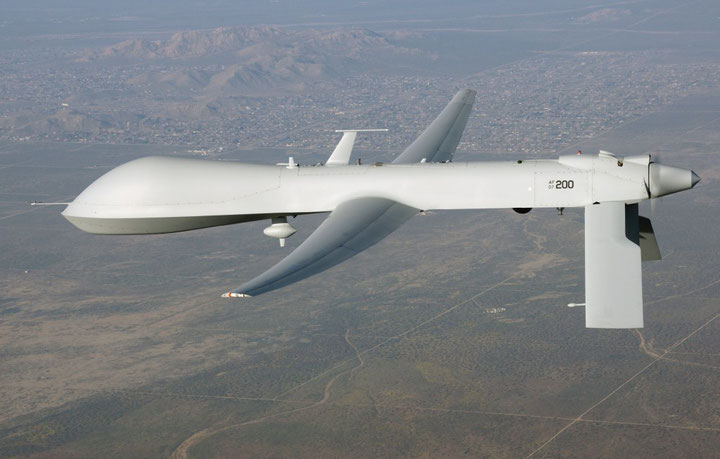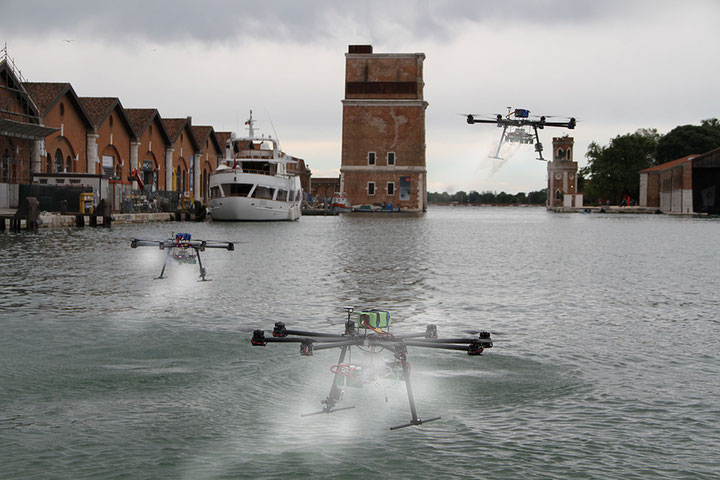Issue 3/2013 - Apparate Maschinen
Murder instrument, art gadget, design object
On the discourse on armed drones
For decades, unmanned aircraft were addressed almost exclusively in the specialised military press and the general public would simply have understood “drone” to mean a male bee. That has changed fundamentally in the course of just a few years: an intensive and critical debate on the utilisation of armed drones in particular began in the USA, and has fanned out from there.1 In addition to ethical issues, the discussion focuses above all on legal issues – “targeted killings” by remote-controlled CIA drones in hundreds of deployments, for example in Yemen or Pakistan, seem hard to reconcile with the traditional principles of international law.
US President Obama has repeatedly handed down death sentences, even vis-à-vis American citizens, without any court proceedings being held, and has had these decisions implemented by remote control. In October 2011 in Yemen a drone killed a US citizen, who was, to boot, still a minor, by the name of Abdulrahman al-Awlaki, the son of an alleged Al-Qaida commander. His father had lost his life in the same way just weeks before. In early May 2013, Pakistan’s Supreme Court in Peshawar ruled that US drone attacks on Pakistan’s territory were not only human rights violations, but also infringed both the UN Charter and the Geneva Convention, and should thus be treated as war crimes. Since 2004 between 2,000 and 3,500 people have died in drone attacks in Pakistan – a country which is not at war with the USA.
The current discourse is probably just the start. For this type of drone has the potential to have a lasting influence on global development – particularly due to the likely spread of the new weapon. A massive upsurge in problematic deployments of drones around the globe in the near future looks probable. Following in the footsteps of the USA and Israel, who have played a pioneering role, a growing number of states are currently procuring drones. Or indeed developing their own models: in May 2013 international media reported on a Chinese stealth drone, which is virtually impossible to detect on radar screens and which experts believe could constitute a threat for Taiwan.2
At the same time an arms race is underway in the civilian sector too: anti-terror units deploy drones above New York in series eight (first screened in 2010) of the US television serial 24, which is an important bellwether and a propaganda platform for apologists of the “war on terror” and its methods. On the other hand, as early as series six of the same serial (screened in 2007) terrorists with a Scaled Composites Model 396 drone bearing a nuclear bomb threatened to raze San Francisco to the ground.
It seems reasonable to believe that this kind of utilisation is highly improbable – due, if nothing else, to technical barriers in constructing portable nuclear bombs, if for no other reason. Generally speaking it seems likely that drones will primarily be deployed without weaponry in the future and will serve mainly as a device of the surveillance state. The rapid pace of technical progress and the associated fall in cost means that drones are in theory becoming affordable for private individuals and institutions too. Radiating out from the USA, journalistic uses of drones have been on the agenda recently too – the Nebraska-Lincoln University has already set up a “Drone Journalism Lab”, launched in 2011. The focus in this context is on low-cost aerial photography, which could certainly offer added value for journalists in a number of situations, such as large demonstrations, catastrophes or armed conflicts. It is still debatable issue whether and to what extent this will be possible in legal terms: a draft bill drawn up by the Austrian Infrastructure Ministry contains demanding bureaucratic criteria that must be met for private use of drones, which would make journalistic applications expensive and hence extremely rare.3
At the same time, artists are also beginning to address the topic. Back in 2011, Israeli video artist Omer Fast shot the short film 5,000 Feet is the Best. It addresses the lethal work of a US drone “pilot” steering drones from a military base close to Las Vegas, surveying the situation from the other end of the world and indeed also firing rockets. An altitude of 5,000 foot (1,500 metres), the drone operator tells us, works best when targeting people.
It has also been striking recently to see drones – to date, only unarmed versions – used to artistic ends in pieces that made playful statements: Chinese artist Yuan Gong set small drones circling, sometimes emitting small clouds of fog, in a piece shown in the margins of the 2013 Venice Biennale. It is impossible to detect any kind of critical dimension here, despite the militaristic ring of the title for this performance – Air Strikes Around the World. That also holds true for a project from Austria: the Ars Electronica Center (AEC), one of the leading creators of art-related electronic gadgets in the country, drew pictures in the night sky above Linz last year with a swarm of 49 mini-drones. A few months later the AEC was commissioned for an advertising stunt in London and created a temporary Star Trek logo there out of mini-drones. The Linz team’s striking technical achievement made waves internationally in the media. However, it is clearly not possible to identify any potential for critical reflection on the new technology in this project, and this was doubtless not its aim either.
Presentations of potentially life-threatening drones in a museum context over the last few years have also lacked critical distance. This becomes apparent in the Smithsonian National Air and Space Museum in Washington D.C., which had a show on the topic that was sponsored by the leading drone manufacturer, General Atomics Aeronautical Systems. Six drones from the U.S. Air Force arsenal can be viewed in the museum – which appears to be particularly proud to display a MQ-1L Predator A (manufacturer: General Atomics): the specific exemplar was the first predator drone to fire Hellfire rockets in a combat context. “The combination of Predator and Hellfire rockets was most frequently deployed in the initial months of the war against terror when CIA ground forces carried out attacks on Al-Qaida troops”, the accompanying text explains.
The shifting significance of drones, which were almost exclusively deployed for surveillance purposes before 2001, also affects the only serious Austrian product on the international market. Schiebel Elektronische Geräte GmbH produces the Camcopter S-100 in Wiener Neustadt – and donated a copy to the design collection of New York’s Museum of Modern Art in 2006. The drone in question, which is reminiscent in formal terms of a small helicopter, was shown at MoMA in 2011/12 as part of the exhibition Contemporary Galleries: 1980–Now. The accompanying text, published on the museum’s homepage, lists numerous potential civilian uses of the Austrian product.
However, MoMA does not breathe a word about the S-100’s explicitly military uses. In 2008 it was revealed that fitting it with two air-to-ground rockets from the international arms manufacturer Thales turns it into a deadly weapon. After public criticism, the manufacturer, Schiebel, also played down this belligerent potential: the emphasis in the company’s current brochures is on civil applications – virtually the only military use mentioned is remote surveillance in the context of PSYOPs (“psychological operations”). A few years ago it was primarily the combat viability of its product that the company underscored, stressing for example that the device can detect targets for artillery fire or is suited in the context of “specialised military uses” for “precision delivery, and recovery, of remote controlled munitions”. It is unclear whether this euphemism was also meant to refer to remote-controlled manslaughter.
In 2011 the Camcopter S-100 was also shown as part of a primarily student design exhibition at the Kunsthaus Graz, with no reference whatsoever to the associated problematic issues – the device’s acclaimed designer, Gerhard Heufler (1944–2013), taught at the Styrian University of Applied Sciences, the Fachhochschule Joanneum, until shortly before his recent death. Heufler responded to criticism around the exhibition by insisting that he would refuse to design active combat material. However, he explained that when he received the commission from Schiebel in 2000, there had been talk of mine detection and no mention at all of active involvement in combat. At the time however Heufler did not distance himself from this work, which received the Austrian Design Award in 2005.
Yet at the latest in 18th October 2001, when a historic piece was published in the Washington Post 4 it would certainly have been possible to guess what kind of role might be assumed by drones in the future. The newspaper referred to a “revolutionary step in warfare”, just a few days after the initial deployment of the MQ-1L Predator A (which would be relegated to a museum nowadays). Critical public discourse has grown increasingly vociferous since then, stirred up in particular by President Obama’s policies: whereas rocket-bearing drones had been used very sparingly whilst his predecessor, George W. Bush, was in office, the number of drone deployments and the number of victims has increased exponentially during Obama’s presidencies. The numerous publications on the topic, recently in particular, make one point clear above all: the world has arrived in a new age of the drones.
Translated by Helen Ferguson
1 C.f. Claire Finkelstein et al. (ed.), Targeted Killings: Law and Morality in an Asymmetrical World. Oxford 2012; Zygmunt Bauman/David Lyon, Liquid Surveillance: A Conversation. Cambridge/Malden 2012; Medea Benjamin, Drone Warfare: Killing by Remote Control. Ashland, Oregon 2012; Armin Krishnan, Gezielte Tötung: Die Zukunft des Krieges. Berlin 2012 (c.f. the review by Thomas Edlinger in springerin 1/2013). Mark Mazzetti, The Way of the Knife. New York 2013; Jeremy Scahill, Dirty Wars. London 2013.
2 “Chinese drones pose threat: experts”, in: Taipei Times, 6.5.2013; www.taipeitimes.com/News/front/archives/2013/05/06/2003561559.
3 “Bures lässt Drohnen nicht mehr frei herumfliegen”, in: Die Presse, 24.4.2013; http://diepresse.com/home/politik/innenpolitik/1393589/Bures-laesst-Drohnen-nicht-mehr-frei-herumfliegen
4 “U.S. arms unmanned aircraft”, in: The Washington Post, 18.10.2001.

